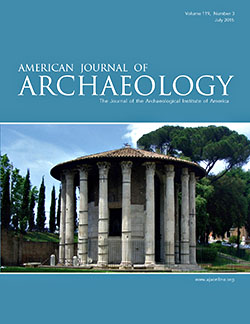AJA Open Access
BY-NCJuly 2015 (119.3)
Book Review
Bones, Behaviour and Belief: The Zooarchaeological Evidence as a Source for Ritual Practice in Ancient Greece and Beyond
Edited by Gunnel Ekroth and Jenny Wallensten
Reviewed by Nerissa Russell
I am a prehistorian, but a few years ago I had occasion to survey the literature on sacrifice in the classical world in general, and zooarchaeological studies of it in particular. My hope was that this well-documented period would provide some guidance for approaching prehistoric sacrifice, where we must rely entirely on archaeological evidence. While I did find useful insights, I was struck by the inadequacy of most zooarchaeological work on classical sacrifice, especially in the ancient Greek world. Too often, zooarchaeologists did not make much use of contextual information, assuming uncritically that any animal remains from a sacred district must derive from sacrifices. Sacrificial assemblages or those from sacred areas were almost never compared with those from residential areas, a basic step in understanding sacred/profane distinctions and the circulation of sacrificial animals as well as in settling the debate over whether all meat consumed in classical Greece derived from sacrifice. There were some happy exceptions (some of them written by contributors to this volume), but it was clear that the considerable potential of zooarchaeology to illuminate classical Greek sacrifice remained unfulfilled.
Apparently I was not alone in noticing these problems; the volume reviewed here derives from a conference held at the Swedish Institute at Athens in 2009 addressing these very issues and the most productive ways to integrate textual and zooarchaeological evidence into the study of sacrifice. As a collection of rigorous, thoughtful, and sophisticated work on sacrifice, it may mark a turning point in classical archaeology, where zooarchaeology becomes as indispensible as it has been for some time in prehistoric studies. Many of the discussions in this volume parallel those in historical archaeology: what can (zoo)archaeology add that we do not already know from the texts? Here, too, the answer is an understanding of the actual practices of ordinary as well as elite people and of the range of variability, rather than normative prescriptions. Zooarchaeological studies reported in this volume and elsewhere demonstrate that sacrificial practice was flexible, and distinctions between sacred and profane, Olympian and chthonian, and offerings appropriate for different deities were fuzzier than they would appear from literary evidence.
The volume has a core of 15 chapters, sandwiched by introductory and concluding chapters. It is generally well produced (save a figure referred to in the text of one chapter but not present), with a unified index and a set of summary maps of sites mentioned in the text at the end of the volume. The trajectory runs approximately from early chapters emphasizing methodological concerns through more empirical case studies (still with discussion of methodological issues) to some evaluative chapters at the end. Four of the chapters are in French, and the rest are in English; of the 15 core chapters, 10 cover ancient Greece (Neolithic–Roman, but mostly classical), 4 deal with the Iron Age elsewhere in Europe (France and Sweden), and 1 treats Hittite Anatolia.
Several chapters discuss definitions of sacrifice and of ritual, although these topics are dealt with more thoroughly in other publications. The most useful intervention here is an argument, supported with zooarchaeological evidence (in chapters by Ekroth; Gardeisen; Vretemark; Isaakidou and Halstead; Magnell; and Georgoudi, Mehl, and Prost), that in ancient Greece and elsewhere there was not a binary distinction between slaughter and sacrifice, secular and sacred, but rather varying degrees of sacredness and ritualization applied both within sacred places and in daily life. Some chapters use zooarchaeological data, experiments, and practical knowledge of animals and their remains to clarify incomplete or ambiguous descriptions and depictions of sacrificial rituals (Vretemark; Popkin; Magnell; Ruscillo; Forstenpointner, Galik, and Weissengruber), or they explore forms of sacrifice/offerings not attested in texts (Mylona, Theodoropoulou—and really, all the chapters show greater variability in practice than texts would indicate).
For zooarchaeology to make meaningful contributions to the study of sacrifice, the authors emphasize the importance of good recovery and contextual information, and they draw on selection of taxa, body parts, and treatment of the animal remains to demonstrate the power of zooarchaeological interpretation. Several stress a taphonomic approach to understanding archaeological contexts (in the broader sense of taphonomy; depositional history might be a better term). Chapters by Magnell and by Brun and Leguilloux both take a chaîne opératoire approach, defining decision points in the sacrificial process that can be identified and compared archaeologically.
Individually, and especially taken as a whole, the chapters in this volume make a strong case for the key role of zooarchaeology in the study of animal sacrifice. They are written to be accessible to archaeologists without zooarchaeological training and will also serve as a good introduction to the methods of studying animal ritual. This book is required reading for anyone who cares about ancient Greek sacrifice, and it will also be rewarding for those with an interest in the archaeology of ritual or social zooarchaeology more generally. It bodes well for the future that a thriving community of scholars is realizing the potential of zooarchaeology in combination with other lines of evidence to expand our understanding of sacrificial practice.
Nerissa Russell
Department of Anthropology
Cornell University
nr29@cornell.edu
